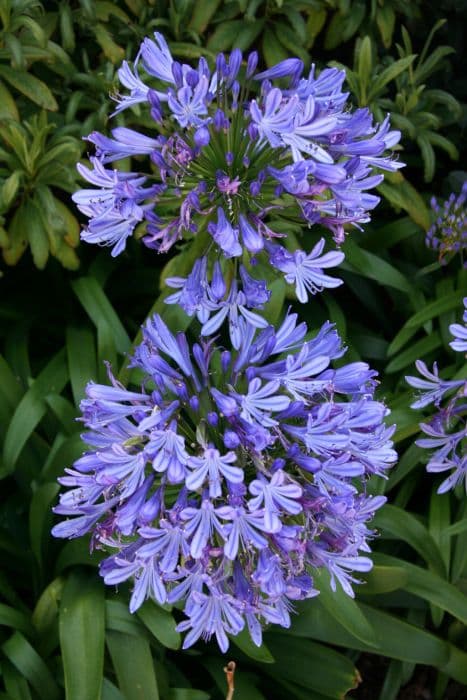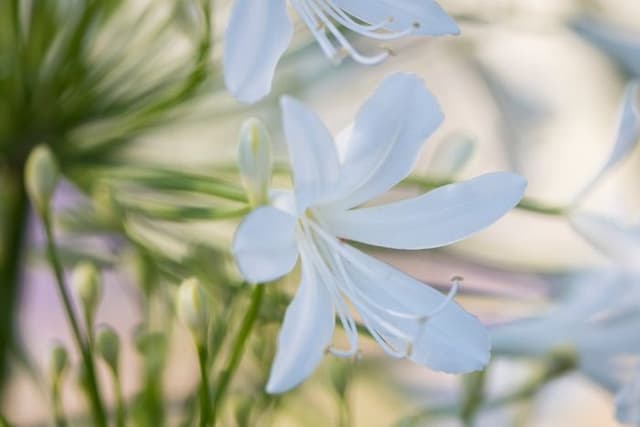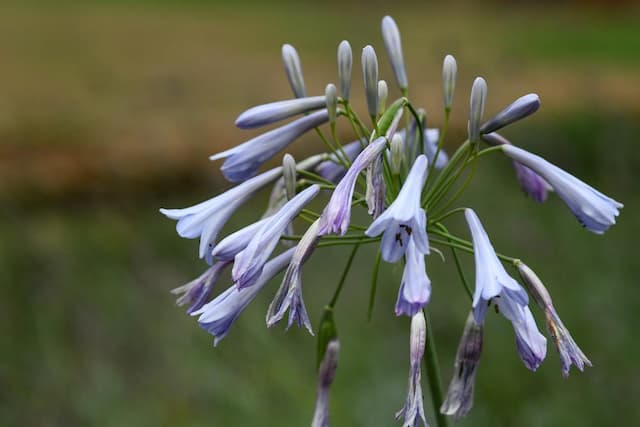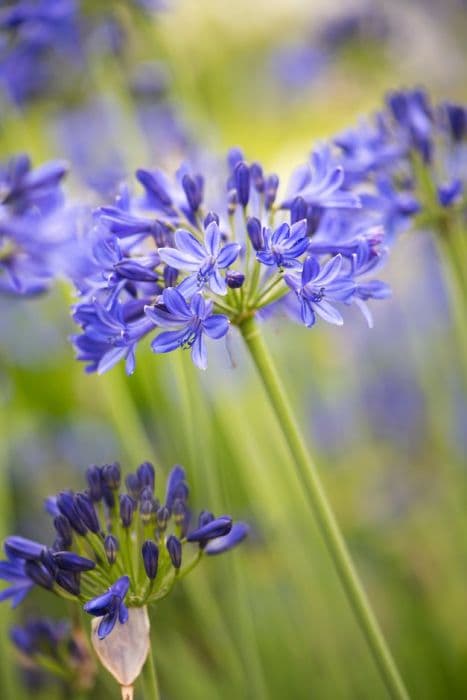African Lily Agapanthus 'Blue Ribbon'

ABOUT
Agapanthus 'Blue Ribbon' is known for its eye-catching, rich blue flowers that form in round clusters atop long, sturdy stalks, emanating a lush and vibrant aura in garden spaces. Each cluster is comprised of multiple trumpet-shaped individual blooms, which collectively create an almost spherical floral display that's akin to a fireworks burst. The foliage of Agapanthus 'Blue Ribbon' is also notable, with long, arching, strap-like leaves that offer a complementary green backdrop to the striking blue flowers. These leaves are glossy and have a smooth texture, which adds to the elegance of the plant. Agapanthus 'Blue Ribbon' projects an overall appearance of grace and stature, with its bold blooms and verdant foliage making it a popular choice for ornamental purposes in a variety of outdoor landscapes.
About this plant
 Names
NamesFamily
Amaryllidaceae.
Synonyms
African Lily, Lily of the Nile, Love Flower.
Common names
There are no synonyms for the Agapanthus 'Blue Ribbon'; the basic scientific name provided is the valid one for this specific cultivar.
 Toxicity
ToxicityTo humans
The Agapanthus, commonly known as Lily of the Nile, has parts that are considered poisonous to humans if ingested. The toxic components are primarily saponins and glycosides, which can cause symptoms such as nausea, vomiting, diarrhea, and abdominal pain. Ingesting large quantities could potentially lead to more severe reactions, so it's advised to keep the plant out of reach of children and to seek medical attention if ingestion occurs.
To pets
Lily of the Nile is toxic to pets, particularly to cats and dogs, if ingested. The toxic compounds, including saponins and glycosides, can cause symptoms such as vomiting, diarrhea, abdominal pain, salivation, and lethargy. In severe cases, it may result in tremors or cardiac problems. If you suspect your pet has ingested any part of the plant, contact your veterinarian immediately for assistance.
 Characteristics
CharacteristicsLife cycle
Perennials
Foliage type
Evergreen
Color of leaves
Green
Flower color
Blue
Height
2 feet [60 cm]
Spread
2 feet [60 cm]
Plant type
Bulb
Hardiness zones
8
Native area
South Africa
Benefits
 General Benefits
General Benefits- Ornamental Appeal: Adds vibrant blue blooms to gardens and outdoor spaces, enhancing aesthetic value.
- Drought Tolerance: Once established, can tolerate dry conditions, reducing the need for frequent watering.
- Perennial Growth: Returns each year, minimizing the need to replant annually.
- Easy Maintenance: Requires minimal care, making it suitable for novice gardeners.
- Attraction of Pollinators: Flowers attract bees and butterflies, promoting pollination in the garden.
- Border Planting: Ideal for planting at the edges of beds or walkways, providing structure and color.
- Container Gardening: Adaptable to pots and containers, offering flexibility in garden design.
- Long Blooming Period: Flowers from late spring through summer, providing a prolonged display of color.
 Medical Properties
Medical PropertiesThis plant is not used for medical purposes.
 Air-purifying Qualities
Air-purifying QualitiesThis plant is not specifically known for air purifying qualities.
 Other Uses
Other Uses- Agapanthus, also known as the African lily, can be used in floral art due to their long-lasting blossoms and strong stems that hold up well in arrangements.
- The Fibonacci sequence is often observed in the spiral arrangement of Agapanthus buds, making them an interesting plant for teaching mathematical concepts in botany.
- These plants are often used as a natural dye source, with the flowers creating shades of blue and purple, while the leaves produce green hues.
- The seed pods of Agapanthus have a unique, architectural form and can be dried and used in crafts or as decoration in dried flower arrangements.
- Agricultural researchers sometimes utilize hybrid Agapanthus varieties like 'Blue Ribbon' to study genetic traits and hybrid vigor in plant breeding programs.
- Dried and pressed Agapanthus flowers can be incorporated into handmade paper, adding texture and natural patterns to the material.
- Due to their clumping nature, Agapanthus plants are used in erosion control, as their roots help stabilize the soil on slopes and banks.
- In landscape design, Agapanthus 'Blue Ribbon' is used to create a rhythm or continuity in garden borders by repeating their placement at intervals.
- Agapanthus can serve as an indicator plant in gardens, signaling over-watering if the leaves start to turn yellow, which can help gardeners adjust their watering schedules.
- The contrasting color and striking form of Agapanthus make them suitable for use in photographic studies and art classes focusing on still life and botanical illustration.
Interesting Facts
 Feng Shui
Feng ShuiThe African Lily is not used in Feng Shui practice.
 Zodiac Sign Compitability
Zodiac Sign CompitabilityThe African Lily is not used in astrology practice.
 Plant Symbolism
Plant Symbolism- Love Letters: The name "Agapanthus" is derived from the Greek words "agape," meaning love, and "anthos," meaning flower. This has led to the plant symbolizing love letters, or the message of love carried over distances.
- Beauty: With its striking blue flowers, the African Lily is often associated with beauty and elegance, making it a popular choice in gardens and floral arrangements.
- Fertility: In some cultures, the lush, full heads of the flowers are symbolic of fertility and creation.
- Endurance: The African Lily is known for its hardiness and ability to thrive in various conditions, symbolizing resilience and enduring love.
- Protection: Some believe that Agapanthus has protective qualities, guarding against evil influences and fostering a safe environment.
 Water
WaterLily of the Nile, commonly known as Agapanthus 'Blue Ribbon', should be watered regularly to keep the soil consistently moist, especially during the growing season in spring and summer. As a guideline, water once a week providing about 1 inch of water, which translates to roughly 0.62 gallons per square foot. During hotter, dry periods, you may need to water twice a week. Reduce watering in the fall to encourage the plant to prepare for dormancy and during winter, water sparingly, just enough to prevent the soil from completely drying out.
 Light
LightLily of the Nile thrives in full sun conditions, where it can receive at least 6 to 8 hours of direct sunlight daily. The best spot for this plant would be in a southern or western exposure garden bed or against a wall that reflects additional sunshine. Partial shade is tolerated but may result in fewer blooms.
 Temperature
TemperatureAgapanthus 'Blue Ribbon' or Lily of the Nile prefers warm temperatures and grows best when the temperature ranges between 60-80 degrees Fahrenheit. It can survive brief periods of colder weather down to about 50 degrees Fahrenheit but should be protected from frost. High temperatures above 90 degrees Fahrenheit can stress the plant; therefore, provide some afternoon shade if consistently high temperatures are common in your area.
 Pruning
PruningPrune the Lily of the Nile after the flowers have faded to keep the plant looking tidy and to encourage more blooms for the next year. Cut back spent flower stalks to the base. Additionally, remove dead or damaged leaves at the base as needed. The best time to prune is in late fall or early winter before new growth begins.
 Cleaning
CleaningAs needed
 Soil
SoilAfrican Lily 'Blue Ribbon' thrives in a soil mix that ensures good drainage, such as a blend of loam, sand, and compost or aged manure. The ideal pH for this plant is slightly acidic to neutral, ranging from 6.0 to 7.0. A layer of mulch can help retain moisture and keep the roots cool.
 Repotting
RepottingAfrican Lily 'Blue Ribbon' does not need frequent repotting and can be done every 2 to 3 years. They prefer being slightly root-bound, so repotting too often is not necessary unless the plant has outgrown its current container.
 Humidity & Misting
Humidity & MistingAfrican Lily 'Blue Ribbon' tolerates a wide range of humidity levels, but it thrives best in moderate to high humidity. It does not require any special humidity requirements when grown in outdoor garden settings.
 Suitable locations
Suitable locationsIndoor
Place in bright light, reduce watering in winter.
Outdoor
Full sun, well-draining soil, protect from frost.
Hardiness zone
8-10 USDA
 Life cycle
Life cycleThe Agapanthus 'Blue Ribbon', commonly known as the African Lily, begins its life cycle when a seed germinates, typically in spring, in well-draining soil and warm conditions. As a perennial, it then develops into a seedling with narrow, strap-like leaves, establishing a root system. The plant enters a vegetative growth stage, growing leaves and stems for several years before becoming mature enough to flower, typically between 2-3 years after germination. Flowering occurs in the summer, producing rounded clusters of tubular blue flowers atop tall, upright stems, attracting pollinators such as bees. Once pollinated, the flowers develop into seed capsules that, when dried, release seeds to start a new cycle. In the absence of pollination or to encourage more vigorous growth, gardeners often propagate the African Lily by dividing its clumps of bulbous roots in the spring or fall.
 Propogation
PropogationPropogation time
Spring-Early Summer
Agapanthus 'Blue Ribbon', commonly known as Lily of the Nile, is typically propagated through division. The best time to carry out this process is in the spring or early summer after the plant has finished blooming. To propagate the Agapanthus 'Blue Ribbon' by division, carefully dig up the clump of the plant, taking care not to damage the roots. Then, using your hands or a sharp knife, divide the clump into smaller sections, each with at least one or two growing points. Replant these divisions promptly, placing them at the same depth they were growing at before and spacing them about 18 inches (approximately 45 centimeters) apart. Water the new plants thoroughly. This method allows the divisions to establish themselves during the growing season, leading to a healthy root system before the colder months.









![African lily [Double Diamond]](/_next/image?url=https%3A%2F%2Fplants-admin.emdemapps.com%2Fimages%2Fplants%2F%2Fimages%2F604b558c4357a.png&w=640&q=75)